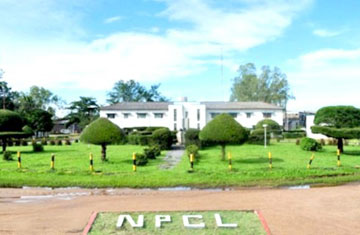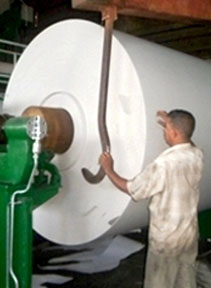Valaichchenai paper mill rises from the ashes
By Shirajiv Sirimane
Like in the present era, the government that was in power in 1955 had
wanted to create an industry to usher in economic prosperity to the
North East. Looking at the resources available the then government
decided to construct a paper mill since there was an abundance of saw
dust available.
|

The facade of the National Paper Company |
Putting this thought into deed, the country’s first paper factory
which was established in 1955 was commissioned for commercial operation
in 1956 at Valaichchenai thus becoming the oldest industry of the
country. The total investment for the factory was Rs. 32 million and 50
percent of it came via a grant.
|

Mangala Senerath |
The government imported German Voith Machines which are considered
the world's leading machines in the industry and the mill was one of the
best factories functioning in South Asia.
Open market policy
Valaichchenai Paper Mills was renamed as Eastern Paper Mills
Corporation in 1958 and the Board Machine was commissioned in 1972. With
the expansion program the second paper mills was put up at Embilipitiya
in 1976 and it was renamed as National Paper Corporation. (Embilipitiya
Paper Mills was later privatized in 2011).
National Paper Corporation was converted into a limited liability
Company from 1992 and incorporated under the Company’s Act No.17 of 1992
as National Paper Company Limited (NPCL). NPCL was the market leader
holding most of the market shares until the implementation of the open
market policy and waiving off the 35 percent tariff on the importation
of paper and the board in 1994 it became bad to worse and the profit
started to drop.
One more reason for waiving off the tariff was the paper mill was in
a terrorism-affected area.
With permanent peace the present government decided to resurrect this
and the task was given to Ministry of State Resources and Enterprises
Development.
Then the Government appointed Mangala Senerath as Competent Authority
of the National Paper Company to turn it into a profit-making venture.
Shrub jungle
“Being a seasoned businessman myself I saw the potential of this mill
and how it could contribute a large portion to the GDP as well.
|

A paper roll inside the mill |
The smooth function of the factory could also uplift the local
industry and save nearly 300 families who are directly employed and some
200 indirectly employed”, said Mangala Senerath.
“When I first visited the Valaichchenai Paper Mills after assuming
office in April 2012, it looked ghostly with damaged buildings and the
area covered by shrub jungle. Employees there were in uncertainty as
they had not been paid their salaries to the value of Rs. 4.5 million
and other payments including welfare facilities.”
In addition corruption and mismanagement too had contributed to the
downfall of the mill.
One of the priorities I saw to get the mill back to its past glory
was to repair the boiler since the steam boiler is the heart of the mill
and without steam, paper couldn't be dried. We called for tenders and
received one for Rs. 26 million.
But we managed to repair this by using our own resources at a cost of
Rs. 11.5 million!,” he said.
In addition several other urgent repairs were done and Valaichchenai
paper mill increased production from 35 to 319 metric tons per month.
Difficulty
He said that due to pressure from environmentalists they were forced
to stop the use of stew dust. It was then decided to use used paper and
paddy husk as the main raw material.
“However, since 20,000 metric tonnes of waste paper is exported to
India every month we face a severe difficulty in finding the waste paper
required for our production.
Of the waste paper exported we need at least 6,000 metric tonnes to
run the mill as we have increased production. Now we are looking for a
way to buy this reused paper. We have suggested a tax to exports which
would discourage the exports of used paper.”
He said that they are now looking at a financial injection to
increase production and meet the future demands of the country which are
very diversified. “With some capital to the mill we will be able to
reach the breakeven point in four months as it would help double our
capacity.”
He said together with the State Resources and Enterprises Development
Minister Dayasritha Tissera their priorities are to turn around this
company in to a profit making venture and they are slowly but surely
moving towards this target.
“Our aim is also to reduce the import of paper thus saving millions
of dollars to the country.”
|

